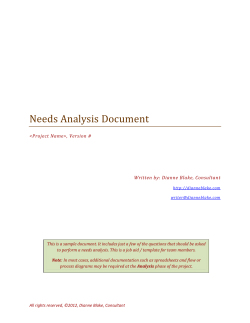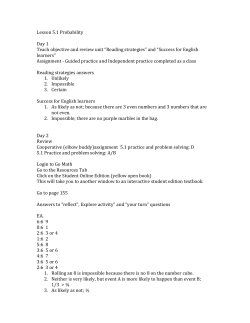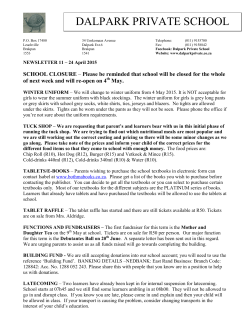
Driving Documents 2.
Overview These resources are aimed at supporting learners who want to develop their language, knowledge and understanding of driving in the U.K. There are four resources. Each resource is aimed at supporting learners at a different level of English. Level • • • • Driving in the U.K. - Driving documents 1. E1 /Access 2 in Scotland/A1 on CEFR Framework Driving in the U.K. - Driving documents 2. E2 (Access 3 in Scotland)/A2 on CEFR Framework Learning to Drive. E2 (Access 3 in Scotland) A2 on CEFR Framework Driving in the U.K. - Court reports. E3/L1 (Intermediate Level 1 in Scotland) B1 on CEFR Framework Learning hours and delivery context Timings are flexible and teachers can break down the units into smaller chunks of learning and build in differentiation, revision and extension activities as required. The resource is suitable for community ESOL and ESOL delivered in adult learning or FE. Additionally, the teacher notes provide suggestions on how practitioners can develop further linked learning. Driving Documents 2. This resource can be completed online or downloaded in paper form to be completed in class. Both the online and paper resources consist of a reading activity, a vocabulary matching exercise, a gap fill exercise, a true /false exercise and an error correction exercise. The paper resource also includes two grammar exercises focussing on the past simple. . Time: approximately 1hr 45. Aims: To teach learners about the documents needed to drive in the U.K. To teach vocabulary associated with driving. To enable learners to practise using the past simple in the context of driving. Objectives: By the end of the session all learners will be able to: © British Council 2012 1 • • • • Demonstrate an understanding of the meaning of key words to do with driving and driving documents. Use these key words to complete comprehension exercises. Form the past simple tense for some regular and irregular verbs. Use the past simple in the context of driving in the U.K. Preparation: You will need: • Access to computers or paper copies of the worksheets. • Pictures of a driving licence. Suggested procedure. Pre-reading/introduction: To introduce the reading activity find out how many learners drive a car and how many own a car. Ask the learners if they are happy to drive in the U.K. Do they find it easier to drive in the U.K. or in their own countries? Show the learners a picture of a driving licence. Ask the learners if any of them have a British driving licence or do they use a driving licence from their country? Explain that it is usually okay to drive on a foreign licence for 12 months but after that learners need to get a British licence. Elicit learners’ knowledge of other documents needed to drive in the U.K. Discuss which documents are needed to drive and which are needed when you are a car owner. Reading. If you have access to computers or an IWB, learners can access the reading directly on the website. Alternatively a paper version can be downloaded from the pdf file under the instructions section. Direct the learners to read the information about driving in the U.K. Ask them to identify the documents discussed and to check which documents are needed to drive a car, and which are needed when you own a car. Learners may benefit from further reading practice by working together in pairs or small groups and reading the text aloud to each other. The teacher can then monitor the groups and check for correct word stress and pronunciation. Check the learners understanding by writing comprehension questions on the board such as: • Can you drive on your own if you have a provisional driving licence? • Why do you need insurance? • What does and MOT check? • Why do you need a tax disc? © British Council 2012 2 Learners can work in groups to discuss the answers and feedback to the class. Activity 1. Match the word and meaning. In this activity learners match words or phrases from the text with their definition. Learners can work in pairs to complete the activity by drawing a line from the word to the definition. They could then swap papers with another pair and check each other’s answers. When the learners have completed the activity read out each definition in turn and ask individual learners to say the corresponding word. Ask the class to repeat each word chorally checking pronunciation and word stress. If the learners have access to computers in the class they can complete the interactive activity under Task 1 of the Driving Resources 2 web page. Differentiation: Less confident learners could find the words from the matching exercise in the text and underline them before completing activity. Activity 2. Gap fill. In this activity learners use the key words they have learned in the previous activity to fill the gaps in a text. Learners can work in pairs taking it in turns to read a sentence and find the missing words. After completing the activity, ask each learner in turn to read a sentence out to the class and drill any words that learners find difficult. This activity could also be used to revise the use of ‘must’ and ‘mustn’t’ with learners. Ask learners to find sentences with must in text. Explain that we use must to talk about things we have to do in certain situations. Discuss what you must do when you drive in the U.K. Elicit sentences using mustn’t such as – you mustn’t use a mobile phone, you mustn’t drive too fast etc. Ask the learners to suggest must and mustn’t sentences for different situations such as in class, in the library, at work etc. An interactive version of this activity can be completed on – line and can be found under task 2 of the Driving resources 2 web page. Activity 3. True or false • • Ask the learners to read through the sentences in pairs. Tell them to decide if the sentence is true or false. Tell the learners to write T or F next to each sentence. As a class read each sentence chorally and ask individual learners if they think the sentence is true or false. With a lively class you could play a game of heads and tails to check answers. Ask learners to stand up and read the sentence chorally as a class. If they think the answer is © British Council 2012 3 true tell them to put their hands on their heads. If they think the answer is false tell them to put their hands on their backs. All learners with the wrong answer have to sit down. Learners still standing when all answers have been given are the winners. An interactive version of this activity can be completed online and can be found under task 3 of the Driving resources 2 web page. Activity 4. Error correction. • • • • Direct the learners to look at the picture of the man driving a car at the bottom of page 5. Explain that this is Hamid and he has just bought a new car. Tell the learners that the car is 3 years old and ask the learners which documents Hamid needs and why. Ask the learners to work in pairs and read through the text. Tell the learners that there are 5 mistakes in the text. Ask the learners to find and underline the mistakes. Tell the learners to swap their papers with another pair and check each other’s answers. Ask the learners to work individually and write the text again without any mistakes. Activity 5. Past simple • Direct the learners to look at the story about Hamid. Ask the learners: When did Hamid pass his driving test. Why did he take the car to the garage? Where did he put the tax disc? What did he look for on the internet? • Ask the learners if the text is in the past or the present. Ask the learners to identify a past simple form of a verb in the text. Write the example sentence on page 7 for regular verbs on the board. Elicit the formation of the past simple for regular verbs. Write the example sentence showing an irregular verb in the past simple. Explain that for irregular verbs we have to learn the past simple form. Write the example on page 8 for the negative past simple and elicit the formation. Ask the learners to complete the worksheet by writing the correct form of the verbs shown for regular, irregular and negative verbs. Check that the learners have noticed that for regular verbs ending in ‘e’ only ‘d’ is added and for verbs in the negative ‘didn’t + the infinitive’ is used. • • • • • Activity 6. Gap fill. • • • Tell the learners to read the verbs highlighted at the top of the page. Ask nominated learners to give the past simple form of two or three verbs. Ask the learners to write the past simple form of the highlighted verbs in the gaps in the text. Tell the learners to work in pairs to check their answers. Extension. © British Council 2012 4 If the learners would like further information or clarification you could direct them to look at the directgov website. There is a lot of very useful information about all aspects of driving and car ownership on this website. Learners may need a friend or relative to help them with some of the language. © British Council 2012 5
© Copyright 2025









